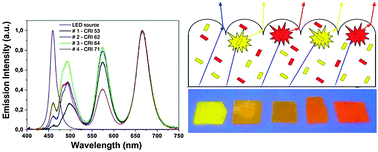Free-standing micropatternable nanocomposites as efficient colour converting filters for light emitting devices†
Abstract
Three different families of chemically engineered rod-shaped CdSe/CdS colloidal nanocrystals have been embedded into a poly(methyl methacrylate) matrix to realize a set of color-tunable photoluminescent filters for RGB light emitting devices, which demonstrate excellent optical transparency (in the range of wavelengths not corresponding to nanocrystal absorption), efficient photoluminescence and good thermal- and photo-stability. Accurate morphological and optical characterization of nanocomposite foils is provided as a function of nanorod size and content, and their color conversion properties are investigated in combination with a blue-emitting LED source. This approach combines the tunable optical features of inorganic quantum-confined light emitters with the facile processability of the polymeric host and offers a highly versatile design tool, which can be exploited in a wide spectrum of lighting and photonic devices. The preparation procedure reported here is even compatible with the implementation of an engineered array of microlens on the front-end surface of the nanocomposite foil and thus makes possible a tailored control of the color-converted photometric pattern.


 Please wait while we load your content...
Please wait while we load your content...